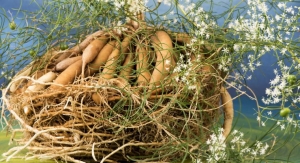Janel Carver 07.01.01
In a struggling industry there are bright spots that shine through with steady growth. One of these is Ayurvedic herbs, a small but vital segment of the nutraceuticals industry. According to Nutrition Business Journal, San Diego, CA, total U.S. sales of Ayurvedic products were roughly $200 million in 1999. In addition, sales in conventional food/drug/mass outlets increased in the year ended March 2001 a whopping 311.2%, to $4.1 million (SPINS, San Francisco, CA). With such increases, many companies are looking to expand their botanical territories to include Ayurvedic herbs.
Perhaps the most important question to answer first is what are Ayurvedic herbs? Ayurveda is made up of two Sanskrit words: Ayu, which means "life" and Veda, which means "knowledge of." Ayurvedic herbs consist of plants that are recommended by the Indian practice, which had its birth over 6000 years ago. Ayurveda is a holistic approach to health consisting of the forces of mind, body, senses and spirit. When one of the four forces is not in sync, illness occurs. Ayurveda practices seek to either rebalance or maintain balance of the forces in the form of individualized food and lifestyle guidelines that should be followed in order to be completely healthy. In acknowledgment of natural forces, Ayurvedic medicine incorporates all elements through the Tridoshas (three doshas), energetic forces that influence nature and human beings.
The three doshas are Vata, Pitta and Kapha. The Vata dosha governs the principle of movement and therefore can be seen as the force that directs nerve impulses, circulation, respiration and elimination. The Pitta dosha consists of the process of transformation or metabolism. The Kapha dosha handles the responsibilities of growth, adding structure unit by unit. In the U.S., these practices are translated for use to the public at large. The herbs and botanicals recommended for Ayur�vedic diets and lifestyles are interpreted for consumption by the mainstream consumer. (For more on Ayurvedic basics, see "Ayurvedic Products: A Primer" on page 46.)
Even though a tough economic climate exists in the U.S., the Ayur�vedic industry seems poised to continue to expand, as awareness about the various indications for Ayur�vedic herbs grows. Industry leaders discussed the potential development of various herbs and conditions.
According to Ronald Schiavello, president, CPB International, Newfoundland, NJ, "Weight management is huge. Ingredients such as Phaseolus vulgaris and garcinia are in huge de�mand. There is no slowdown right now; business is the best it's ever been."
Skipp Silverman, director of marketing, RIA, Whippany, NJ, agreed. "It's a growing field, with calls and questions on Indian and Ayurvedic products coming in more frequently by the day."
Shailinder Sodhi, president, Ayush Herbs, Bellevue, WA, also weigh�ed in on the issue. "Anti-aging products are becoming popular and research is being focused on antioxidant properties and anti-cancers," he said, adding, "Guggul, ashwagandha, amla and ocimum basillicum are all being touted for their benefits, low side effects and non-addictive properties."
Walter Rick, vice president-sales and marketing GCI Nutrients, Burlin�game, CA, added, "Curcumin, which is used for anti-inflammatory purposes, is one of our biggest sellers right now. In addition the breast, prostate and digestive side is huge."
Summing it all up was Todd Norton, president and COO, Sabinsa, Payson, UT. "This is no longer 'just' Ayurvedic medicine; people are taking the best of traditional medicines from around the world and are trying to use them for the most impact. Overall, Ayurvedic is holding its own with steady slow growth."
As an aside, on the cosmeceuticals side of the business, according to Jay Joshi, president, Carlisle International, Lake Forest, IL, "Neutrogena is now using Ayurvedic herbs for acne products and as an insecticide. Looking for 'active' naturals is be�coming more specialized."
As it is in the herbal business in general, there are two camps with regard to standardization of Ayurvedic herbs. On the one side, there are those that want to concentrate on the active ingredients they feel make these botanicals efficacious. On the flip side are those that argue that the entire plant has been used for thousands of years and that the whole form, regardless of active ingredient content, is what should be used.
John Alkire, production manager, AHD International, Atlanta, GA, falls into the former category. "Without standardization you don't know what you're really selling. The industry should come together and be its own watchdog for standardization. Standardization leaves less room for adulteration and standardization and quality control go hand in hand. Quality issues are a large problem due to poverty and lack of sanitary conditions, from the people who literally pick the plant to where it's made. A lot of it is sent back because the herbs aren't clean and are therefore unsafe."
GCI's Mr. Rick concurred. "We use standardized herbs," he said. "The growing focal point is the strength of quality control. Those struggling are those with no quality control standard. People are always looking for price and sometimes when the price is really low so is the quality of herbs. If it doesn't work, people don't buy and repeat consumers become nonexistent."
Yet there are also those that are trying to embrace the whole herbs camp. Recognizing that certain population segments regard whole herbs as the only manner in which to utilize Ayurvedic botanicals, some companies, such as Sabinsa, utilize both. Mr. Norton stated, "Some of our ingredients are standardized, while others are whole herb products. It's important that our customers understand the difference."
With the Ayurvedic industry trying to push the envelope to stake its claim as a scientifically based industry, the future remains challenging as quality issues and negative publicity continue to throw obstacles in the path of success.
According to Mr. Schiavello, "Methods of standardization must be unified. The U.S. Pharmacopoeia has made an inroad into this but more work needs to be done to accomplish our needs."
Echoing the same sentiments, AHD's Mr. Alkire said, "Confusion to the consumer leads to bad stereotypes in the mainstream media. In the next year, the industry will clean itself up due to consolidation and those companies' initiated standards. If there is no national campaign there will be no mass market and therefore no mainstreaming of Ayurvedic products."
Mr. Norton added, "Fundamental things need to change. Once the pain exceeds the fear to change that's when things will start to shift. If we want to be long term, we need to return to the previous level of credibility. Where do we want to be in three years and what do we need to do to get there? Large food companies and pharmaceuticals are looking at us; if we want to be credible we have to set our own guidelines. Before DSHEA we were just trying to protect ourselves and now we are actually looking to expand."
Mr. Norton cautioned, "We need to take a hard look and see what needs to be done and be forward-looking as to the steps to take. A lot is before us. We need to be good caretakers of the past. The landscape is changing but as an industry we have a duty and a say in how that landscape develops. We must do it responsibly or else someone else will do it for us."
Mr. Rick concurred, "We need to align ourselves as a team to survive. Negative press leads people to doubt the products. The industry must be proactive versus reactive. It's expensive to be in business, but it's even more expensive to be out of business. We need to set standards or the government will be more strict and rigid."NW
Brief Overview: Defining Terms
Perhaps the most important question to answer first is what are Ayurvedic herbs? Ayurveda is made up of two Sanskrit words: Ayu, which means "life" and Veda, which means "knowledge of." Ayurvedic herbs consist of plants that are recommended by the Indian practice, which had its birth over 6000 years ago. Ayurveda is a holistic approach to health consisting of the forces of mind, body, senses and spirit. When one of the four forces is not in sync, illness occurs. Ayurveda practices seek to either rebalance or maintain balance of the forces in the form of individualized food and lifestyle guidelines that should be followed in order to be completely healthy. In acknowledgment of natural forces, Ayurvedic medicine incorporates all elements through the Tridoshas (three doshas), energetic forces that influence nature and human beings.
The three doshas are Vata, Pitta and Kapha. The Vata dosha governs the principle of movement and therefore can be seen as the force that directs nerve impulses, circulation, respiration and elimination. The Pitta dosha consists of the process of transformation or metabolism. The Kapha dosha handles the responsibilities of growth, adding structure unit by unit. In the U.S., these practices are translated for use to the public at large. The herbs and botanicals recommended for Ayur�vedic diets and lifestyles are interpreted for consumption by the mainstream consumer. (For more on Ayurvedic basics, see "Ayurvedic Products: A Primer" on page 46.)
Trends: Growth Opportunities
Even though a tough economic climate exists in the U.S., the Ayur�vedic industry seems poised to continue to expand, as awareness about the various indications for Ayur�vedic herbs grows. Industry leaders discussed the potential development of various herbs and conditions.
According to Ronald Schiavello, president, CPB International, Newfoundland, NJ, "Weight management is huge. Ingredients such as Phaseolus vulgaris and garcinia are in huge de�mand. There is no slowdown right now; business is the best it's ever been."
Skipp Silverman, director of marketing, RIA, Whippany, NJ, agreed. "It's a growing field, with calls and questions on Indian and Ayurvedic products coming in more frequently by the day."
Shailinder Sodhi, president, Ayush Herbs, Bellevue, WA, also weigh�ed in on the issue. "Anti-aging products are becoming popular and research is being focused on antioxidant properties and anti-cancers," he said, adding, "Guggul, ashwagandha, amla and ocimum basillicum are all being touted for their benefits, low side effects and non-addictive properties."
Walter Rick, vice president-sales and marketing GCI Nutrients, Burlin�game, CA, added, "Curcumin, which is used for anti-inflammatory purposes, is one of our biggest sellers right now. In addition the breast, prostate and digestive side is huge."
Summing it all up was Todd Norton, president and COO, Sabinsa, Payson, UT. "This is no longer 'just' Ayurvedic medicine; people are taking the best of traditional medicines from around the world and are trying to use them for the most impact. Overall, Ayurvedic is holding its own with steady slow growth."
As an aside, on the cosmeceuticals side of the business, according to Jay Joshi, president, Carlisle International, Lake Forest, IL, "Neutrogena is now using Ayurvedic herbs for acne products and as an insecticide. Looking for 'active' naturals is be�coming more specialized."
Standardized Vs. Non-standardized: The Ongoing Debate
As it is in the herbal business in general, there are two camps with regard to standardization of Ayurvedic herbs. On the one side, there are those that want to concentrate on the active ingredients they feel make these botanicals efficacious. On the flip side are those that argue that the entire plant has been used for thousands of years and that the whole form, regardless of active ingredient content, is what should be used.
John Alkire, production manager, AHD International, Atlanta, GA, falls into the former category. "Without standardization you don't know what you're really selling. The industry should come together and be its own watchdog for standardization. Standardization leaves less room for adulteration and standardization and quality control go hand in hand. Quality issues are a large problem due to poverty and lack of sanitary conditions, from the people who literally pick the plant to where it's made. A lot of it is sent back because the herbs aren't clean and are therefore unsafe."
GCI's Mr. Rick concurred. "We use standardized herbs," he said. "The growing focal point is the strength of quality control. Those struggling are those with no quality control standard. People are always looking for price and sometimes when the price is really low so is the quality of herbs. If it doesn't work, people don't buy and repeat consumers become nonexistent."
Yet there are also those that are trying to embrace the whole herbs camp. Recognizing that certain population segments regard whole herbs as the only manner in which to utilize Ayurvedic botanicals, some companies, such as Sabinsa, utilize both. Mr. Norton stated, "Some of our ingredients are standardized, while others are whole herb products. It's important that our customers understand the difference."
Setting The Pace For The Race
With the Ayurvedic industry trying to push the envelope to stake its claim as a scientifically based industry, the future remains challenging as quality issues and negative publicity continue to throw obstacles in the path of success.
According to Mr. Schiavello, "Methods of standardization must be unified. The U.S. Pharmacopoeia has made an inroad into this but more work needs to be done to accomplish our needs."
Echoing the same sentiments, AHD's Mr. Alkire said, "Confusion to the consumer leads to bad stereotypes in the mainstream media. In the next year, the industry will clean itself up due to consolidation and those companies' initiated standards. If there is no national campaign there will be no mass market and therefore no mainstreaming of Ayurvedic products."
Mr. Norton added, "Fundamental things need to change. Once the pain exceeds the fear to change that's when things will start to shift. If we want to be long term, we need to return to the previous level of credibility. Where do we want to be in three years and what do we need to do to get there? Large food companies and pharmaceuticals are looking at us; if we want to be credible we have to set our own guidelines. Before DSHEA we were just trying to protect ourselves and now we are actually looking to expand."
Mr. Norton cautioned, "We need to take a hard look and see what needs to be done and be forward-looking as to the steps to take. A lot is before us. We need to be good caretakers of the past. The landscape is changing but as an industry we have a duty and a say in how that landscape develops. We must do it responsibly or else someone else will do it for us."
Mr. Rick concurred, "We need to align ourselves as a team to survive. Negative press leads people to doubt the products. The industry must be proactive versus reactive. It's expensive to be in business, but it's even more expensive to be out of business. We need to set standards or the government will be more strict and rigid."NW




















